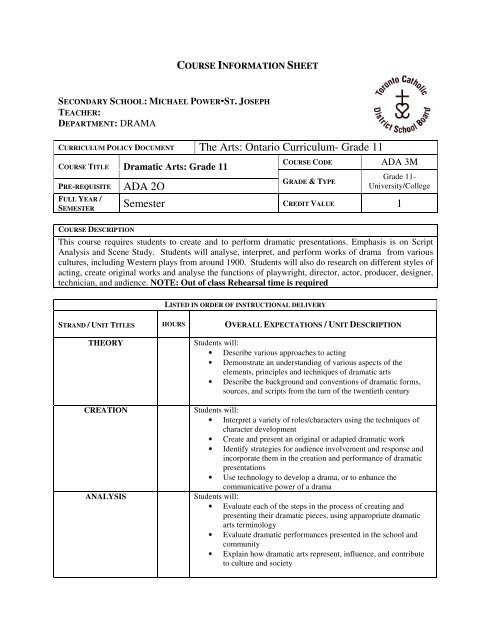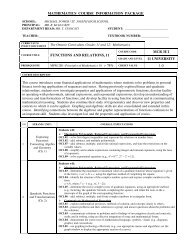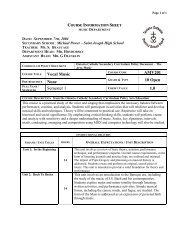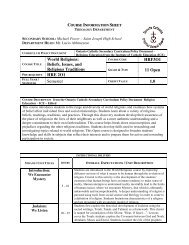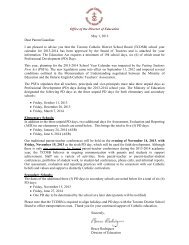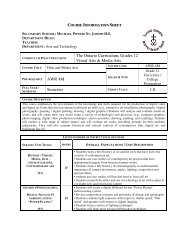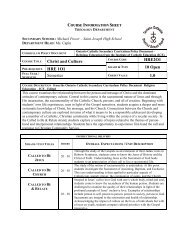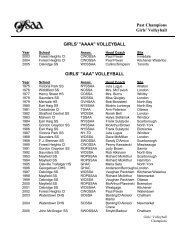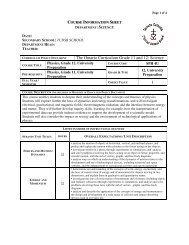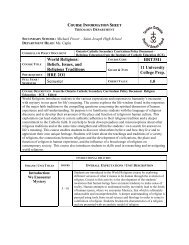The Arts: Ontario Curriculum- Grade 11 ADA 2O Semester 1 - MPSJ.ca
The Arts: Ontario Curriculum- Grade 11 ADA 2O Semester 1 - MPSJ.ca
The Arts: Ontario Curriculum- Grade 11 ADA 2O Semester 1 - MPSJ.ca
- No tags were found...
You also want an ePaper? Increase the reach of your titles
YUMPU automatically turns print PDFs into web optimized ePapers that Google loves.
COURSE INFORMATION SHEETSECONDARY SCHOOL: MICHAEL POWERST. JOSEPHTEACHER:DEPARTMENT: DRAMACURRICULUM POLICY DOCUMENT <strong>The</strong> <strong>Arts</strong>: <strong>Ontario</strong> <strong>Curriculum</strong>- <strong>Grade</strong> <strong>11</strong>COURSE TITLE Dramatic <strong>Arts</strong>: <strong>Grade</strong> <strong>11</strong>PRE-REQUISITE<strong>ADA</strong> <strong>2O</strong>COURSE CODEGRADE & TYPE<strong>ADA</strong> 3M<strong>Grade</strong> <strong>11</strong>-University/CollegeFULL YEAR /SEMESTER<strong>Semester</strong> CREDIT VALUE 1COURSE DESCRIPTIONThis course requires students to create and to perform dramatic presentations. Emphasis is on ScriptAnalysis and Scene Study. Students will analyse, interpret, and perform works of drama from variouscultures, including Western plays from around 1900. Students will also do research on different styles ofacting, create original works and analyse the functions of playwright, director, actor, producer, designer,technician, and audience. NOTE: Out of class Rehearsal time is requiredLISTED IN ORDER OF INSTRUCTIONAL DELIVERYSTRAND / UNIT TITLES HOURS OVERALL EXPECTATIONS / UNIT DESCRIPTIONTHEORYCREATIONANALYSISStudents will:• Describe various approaches to acting• Demonstrate an understanding of various aspects of theelements, principles and techniques of dramatic arts• Describe the background and conventions of dramatic forms,sources, and scripts from the turn of the twentieth centuryStudents will:• Interpret a variety of roles/characters using the techniques ofcharacter development• Create and present an original or adapted dramatic work• Identify strategies for audience involvement and response andincorporate them in the creation and performance of dramaticpresentations• Use technology to develop a drama, or to enhance thecommuni<strong>ca</strong>tive power of a dramaStudents will:• Evaluate each of the steps in the process of creating andpresenting their dramatic pieces, using apparopriate dramati<strong>ca</strong>rts terminology• Evaluate dramatic performances presented in the school andcommunity• Explain how dramatic arts represent, influence, and contributeto culture and society
• Explain how the study of dramatic arts <strong>ca</strong>n foster selfdevelopment and global awareness• Analyse the personal, social and <strong>ca</strong>reer skills acquired throughthe study of dramatic artsUNIT 1:MOVEMENTUNIT 2 :SCENE STUDYUNIT 3 :DOCUDRAMA/COLLECTIVECREATIONUNIT 4:PLAY UNITPERFORMANCEEXAMTechniques: Tableau, ritual, pantomime, mime, Stage fightingMajor Performance Assignments : Ritual, Attic Trunk Pantomime(Solo), Group Pantomime, Day in the Life of… (Solo Mime),Choreographed fight scenarioMime Unit testTechniques : Script Analysis, Subtext, Obstacles, Blocking,Characterization “Inside out and Outside In Approaches”Major Performance Assigments: Open ended scenes, DialoguesAfter Liverpool Subtext Written AssignmentStanislavski Appraoches to Acting AssignmentRealism in <strong>The</strong>atre ESSAYStudents will create a performance piece using a variety of sourcematerial and various modes of dramaPerformance of the Docudrama in some venue at teacher’s discretion andvenue availabilityStudents will analyse an entire script and choose scenes from the play forpresentation.Written Aspect: Script Analysis, Blocking notationPerformance: Individual and Group Evaluation, Peer EvaluationSTUDENT EVALUATION CRITERIATERM – 70% FINAL – 30%10 ≤ RELATIVE EMPHASIS / WEIGHTING ≤ 40 RELATIVE EMPHASIS / WEIGHTINGKNOWLEDGE/UNDERSTANDINGPerformance10Task (Scenes)15INQUIRY/THINKING 10 Written Exam 15COMMUNICATION 25APPLICATION 25TERM TOTAL 70 FINAL TOTAL 30FINAL REPORT CARD GRADECALCULATION – 100%TERM TOTAL + FINAL TOTAL= REPORT CARD MARK
LEARNING SKILLS CRITERIAIN EACH REPORTING PERIOD, REPORT ON THE QUALITY OF THE LEARNING SKILLS DEMONSTRATED BY THESTUDENT IN EACH OF THE CATEGORIES IDENTIFIED ON THE REPORT CARD USING THE FOLLOWING LETTERSYMBOLS.E–EXCELLENT G–GOOD S–SATISFACTORY N–NEEDS IMPROVEMENTSKILL: WORKS INDEPENDENTLYINDICATORS:• accomplishes tasks independently• accepts responsibility for completing tasks• follows instructions• regularly completes assignments on time and with <strong>ca</strong>re• demonstrates self-direction in learning• independently selects, evaluates, and uses appropriatelearning materials, resources, and activities• organizes work when faced with a number of tasks• devises and follows a coherent plan to complete a task• follows specific steps to reach goals or to makeimprovements• revises steps and strategies when necessary to achieve a goal• seeks out new opportunities for learning• responds to challenges and takes risks• demonstrates interest and curiosity about concepts, objects,events, and resources• seeks necessary and additional information in print,electronic, and media resources• identifies problems to solve, conducts investigations, andgenerates questions for further inquiry• requires little prompting to complete a task, displaying selfmotivationand self-directionSKILL: ORGANIZATIONINDICATORS:SKILL: INITIATIVEINDICATORS:SKILL: TEAMWORKINDICATORS:• demonstrates persistence in bringing tasks to completion• uses time effectively• uses prior knowledge and experience to solve problems andmake decisions• reflects on learning experiences• manages and uses time effectively and creatively• demonstrates ability to organize and manage information• follows an effective process for inquiry and research• uses appropriate information technologies to organizeinformation and tasks• approaches new learning situations with confidence and apositive attitude• develops original ideas and devises innovative procedures• attempts a variety of learning activities• seeks assistance when needed• uses information technologies in creative ways to improvelearning for self or others• works willingly and cooperatively with others• questions the ideas of the group to seek clarifi<strong>ca</strong>tion, test• shares resources, materials, and equipment with others thinking, or reach agreement• responds and is sensitive to the needs and welfare of others • shows respect for the ideas and opinions of others in the• solves problems collaborativelygroup or class• accepts various roles, including leadership roles• listens attentively, without interrupting• takes responsibility for his or her own share of the work to be • in discussions, paraphrases points of view and asks questionsdoneto clarify meaning and promote understanding• works to help achieve the goals of the group or the class • recognizes the contribution of group members by means of• helps to motivate others, encouraging them to participate encouragement, support, or praise• contributes information and ideas to solve problems and • seeks consensus and negotiates agreement before makingmake decisionsdecisionsSKILL: WORK HABITS/HOMEWORK• completes homework on time and with <strong>ca</strong>re• puts forth consistent effort• follows directions• shows attention to detail• uses materials and equipment effectivelyINDICATORS:• begins work promptly and uses time effectively• perseveres with complex projects that require sustained effort• applies effective study practicesNOTE: <strong>The</strong> above chart is a reformatting of the skills identified in the Ministry of Edu<strong>ca</strong>tion’s Guide to theProvincial Report Card, <strong>Grade</strong>s 9 – 12 : Appendix C: pages 27 to 29 .


